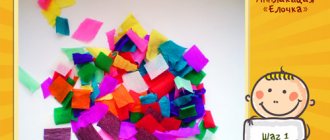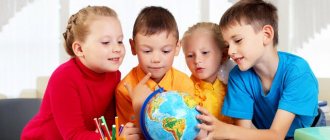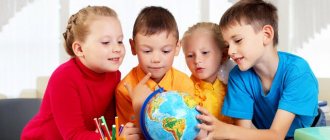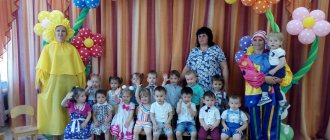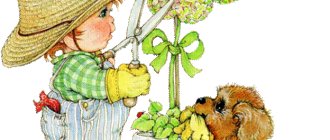Progress of the game:
Children should stand in single file
, holding onto the belt of the person in front.
The teacher blindfolds them and leads them along a certain route, overcoming an “obstacle course.”
(stepping over stones, going around trees, passing low under a lowered branch, etc.). The route is outlined by the teacher in advance and it is better if it goes in a circle. Having reached the beginning, the teacher unties the children's eyes and invites them to go through the same route with their eyes open, without holding on to their belts, in order to be able to look and touch what the teacher told them while going through the obstacle course, but which they themselves did not see. Let the children themselves try to guess where they bent down and where they walked around the stone.
OUTDOOR GAMES “FIND YOUR TREE”
Goal: to provide the opportunity to explore the environment , to use the experience of direct communication with it (carried out in nature)
.
Progress of the game:
The teacher blindfolds one child, spins him around several times and leads him to a tree. The child must explore this tree by feeling it. During the study, the teacher asks guiding questions:
Is it smooth or not?
Does it have leaves?
Do the branches start high from the ground?
Then the teacher takes the child away from the tree, confuses the tracks, unties his eyes and asks him to guess “his”
tree, using the experience gained while feeling the tree.
In the future, you can offer children games in pairs.
OUTDOOR GAMES “OWL AND CROW”
Goal: to test and consolidate children’s ideas about the world around them.
Progress of the game:
Option 1.
All the birds are playing, one child is an owl, which is located on the side of the playground. On the signal "day"
the birds fly away, flap their wings, and peck at the grains.
At the signal “night”
everyone stops and stands
motionless . An owl flies out, looks out for those who move and takes them into the nest. in 15-20 seconds. “day”
signal is given again , the owl flies to the nest, and the children - birds fly around the playground.
Option 2.
Two owls are selected. Take interesting poses.
"Horses"
Goal: to teach children to run, raising their knees high in pairs, without bumping into each other, to perform movements in accordance with the text. Develop coordination of movements, the ability to play in pairs.
Progress of the game:
Children's hares are located in burrows-circles, on the opposite side there is a dog house, in front of it is a vegetable garden with beds (dashes or sticks at a distance of 20-30 cm from one another)
.
The hares run into the garden, jump over the beds. At the signal: “The dog is running,”
they run into the burrows, the dog catches the hares. The game is repeated when the dog catches 2-3 hares. Jump over the beds on two legs, caught hares go to the dog's house, you can't catch hares in burrows.
Complication: the beds can be high.
"Corydalis"
Goal: to teach to act in accordance with the text, to develop creativity. Cultivate interest in folk games.
Progress of the game:
Children should be divided into two teams: “Owls”
and
"Crows"
. Both of them stand in a line opposite each other at a distance of 3 meters, behind them are their houses, also at a distance of 3 meters. The teacher gives the task:
"Owls"
love the truth,
the Ravens
love lies, so if I tell the truth,
the Owls
must catch
the Ravens
.
"Crows"
run away to their homes and vice versa.
Then the teacher pronounces phrases of natural history content:
bears love to eat tigers
birch trees have earrings in spring
elephants can't swim
dolphin is an animal, not a fish
Children must realize the correctness or incorrectness of the phrase, based on their knowledge on this topic, and react with their own behavior (run away or catch up)
to this phrase. After each time, it is advisable to ask the children why they acted one way or another, and after 2-3 phrases, change the players’ places.
"Owl"
Goal: to teach children to run scattered around the playground, pretending to be birds, and take a static position when given a signal. Develop the ability to act on a signal and imagination. Change movements.
Progress of the game:
A small square is drawn on the ground - a house. Around it are four cardboard leaves , four hummocks interspersed - a pond. 4-6 guys play. One is a frog, the rest are baby frogs. A frog teaches baby frogs to jump. She stands to the right of the pond, the frogs to the left. Each frog stands in the house and, listening carefully to the commands, jumps, pushing off with both feet and landing on both feet. The frog clearly gives the command: hummock, leaf, leaf, house, leaf, hummock, hummock!
One frog jumps, the rest watch to see if he is doing the right thing. If the frog jumped correctly and did not mix up any commands, he stands next to the frog, and if he made a mistake, he returns to the frogs.
"Birds and Cat"
Goal: to teach children to jump from benches onto their toes with bent legs, run around the playground in all directions, and, at a signal, climb onto benches without holding on to each other. Develop the ability to act on a signal and speed of movement.
Progress of the game:
Option 1.
Children become pairs: one is a rider, the other is a horse. Reins are given for the game. Children run around the hall raising their knees high. The teacher says:
Let's go, let's go
With nuts, with nuts.
Give grandpa a turnip,
According to the boy
For sweets.
Children run around clicking their tongues. When the teacher says: “Wow…”
the children stop and change roles.
Option 2.
At the teacher’s signal, the riders catch the horses, harness them (put on the reins)
. At the direction of the teacher, children can ride quietly, trot or gallop. After some time, the horses are unharnessed and released into the meadow, and the riders sit down to rest. After 2-3 repetitions, children change roles.
"Frogs"
Goal: to teach children to jump, pushing off and landing on both feet, and to correctly follow the command. Develop attention and the ability to act on a signal.
Progress of the game:
Option 1.
3-4 children represent birds, the rest are chicks, one child is a cat. Before the start of the game, the birds and chicks are in the trees - they climb onto a hill, fly out (they jump on both legs, only when called, birds and run within the area. At the teacher’s signal, the chicks fly to the hills, and the cat tries to catch the birds . The cat cannot catch someone who is standing on a hill. The cat is trying to catch the birds.
Option 2.
A large circle is drawn or laid out from a cord. Children - birds stand in a circle on the outside. One child is designated as a cat and stands in the center of the circle. The cat falls asleep, and the birds jump into the circle and fly there, sit down, and peck the grains. The cat wakes up and begins to catch the birds, and they run away out of the circle. The cat leads the caught birds to the center of the circle.
"Hares"
Goal: to teach children to jump over strips 20-30 cm wide. on two legs, landing on your toes with half-bent legs. Run quickly into the holes at the signal. Develop agility, speed and accuracy of movements.


